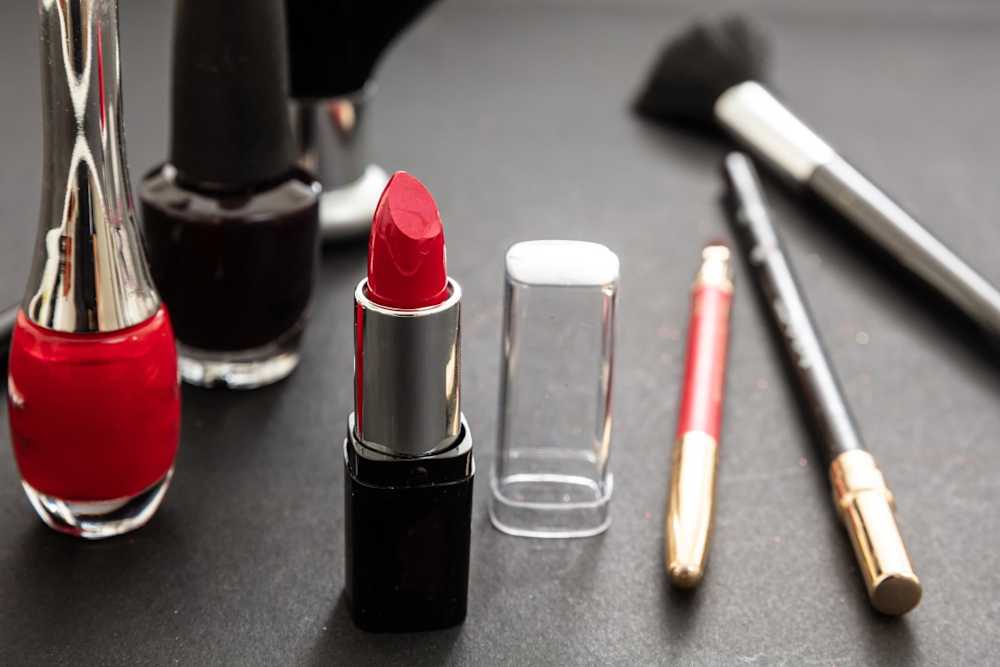The European Union has strict product safety standards to protect consumers from hazards that faulty products may cause. When dangerous products are discovered by national authorities, they are reported on the Safety Gate Rapid Alert System, along with a set of information on the product’s origin and the types of risks identified.
This article provides a detailed overview of Safety Gate data for 2023, offering insight into the typical reasons why different types of products were found to endanger consumer safety.
Summary of key findings:
There was a significant 63% increase in the number of serious risk alerts from 2022 to 2023.
The increase is largely explained by 1,000+ cosmetics products found to contain the recently banned fragrance BMHCA, also known as Lilial.
Other product categories with increasing numbers of high-risk products included electrical appliances and clothing, textiles & fashion items.
More than 70% of dangerous products in several categories, including toys, electrical appliances, and jewelry, originated from China.
Table of contents
Dangerous products in 2023: Cosmetics, motor vehicles, and toys were the leading categories
In 2023, a total of 3,130 serious risk alerts were registered on Safety Gate, representing situations where products have been found to cause a serious risk to consumers or the environment. This represents an increase of 62.8% from the 1,923 serious risk alerts reported in 2022.
When sorted by product category, cosmetic products were found to be the most hazardous, accounting for 34.7% of total alerts in 2023. Toys (13.3%), motor vehicles (12.8%), electrical appliances (9.0%), and clothing & textiles (8.8%) were also often flagged as dangerous.

The largest number of dangerous products originated from China (34.5%), followed by Italy (15.9%), Germany (5.8%), France (5.7%), and Poland (4%). The country of origin was unknown in 11.8% of the cases. Dangerous Chinese products were most often toys, electrical appliances, or jewelry. Italy was a major source of non-compliant cosmetics and Germany of motor vehicles.

Cosmetics: use of unauthorized fragrance BMHCA was the leading reason behind serious risk alerts in 2023
Cosmetics were the product category with the highest number of serious risk alerts in 2023 with a total of 1,084 dangerous products. Nearly all alerts (98.7%) were filed due to a chemical hazard. Some products (0.7%) posed a microbiological risk, and individual products were flagged for environmental risks, choking hazards, and health risks relating to an insufficient sun protection factor.
By far the most common chemical hazard in the cosmetics category was the presence of BMHCA, better known by the trade name Lilial. BMHCA used to be a common fragrance in cosmetic products, but its use has been banned since March 2022 due to the harm it may cause to the reproductive system. 92.9% of dangerous cosmetic products were flagged for Lilial.
Other typical chemical hazards in the cosmetics category included the following:
Hydroquinone, which can cause skin irritation, dermatitis, and cancer, was found in 17 products.
Isothiazolinones, biocides whose use in cosmetic products is restricted due to their propensity to cause allergenic reactions in sensitized people, were found in 8 products.
The heavy metal mercury, which accumulates in the body, can damage several organs, and may affect reproduction, was discovered in 8 products.
The allergenic fragrance hydroxyisohexyl 3-cyclohexene carboxaldehyde (HICC, also known by the trade name Lyral), was found in 8 products.
Restricted hair dye ingredient p-phenylenediamine (PPD), which may cause extreme dermatitis, was found in 6 products.
An excessive concentration of hydrogen peroxide was discovered in 5 products.
Measurlabs’ testing expert Pasi Tuomikoski considers the array of chemical contaminants discovered in cosmetics quite typical. Even the high number of Lilial-containing products does not surprise him, as it often takes some time for manufacturers and importers to adapt to changes in legislation.
"With some imports from third countries, it may be so that Lilial is allowed in the country of origin, and the EU ban is not considered due to neglect when the product is brought to market here. Additionally, it seems that some European manufacturers have failed to react to the ban in time, as Lilial was openly listed as an ingredient in hundreds of products manufactured in EU countries," Tuomikoski says.
According to the expert, illegal fragrances like Lilial may also end up in cosmetics as unintentional contaminants. A typical reason for this is their presence in fragrance mixtures.
"Cosmetic manufacturers and importers should implement proper quality control measures to verify batch-to-batch compliance and purity of raw materials to ensure contaminated products do not reach the market," Tuomikoski stresses.
Safety Gate statistics show that Italy was the most common country of origin for dangerous cosmetics discovered in the EU in 2023 with approximately 33% of all cosmetics alerts filed for Italian products. Most of these alerts were filed by Italian authorities, who registered more than 90% of all serious risk alerts related to domestically produced cosmetics.
Other common countries of origin for dangerous cosmetics included France, Poland, Spain, and China. In addition to Italy, rigorous market surveillance was performed in Hungary and Romania.
Toys: choking hazards and phthalates were the most common serious risks in 2023
416 toys were found to cause a serious risk to consumers or the environment in the EU in 2023. The hazards were most often related to chemicals and choking. Many toys posed several risks simultaneously, for example, containing both restricted chemicals and small parts that children may choke on.
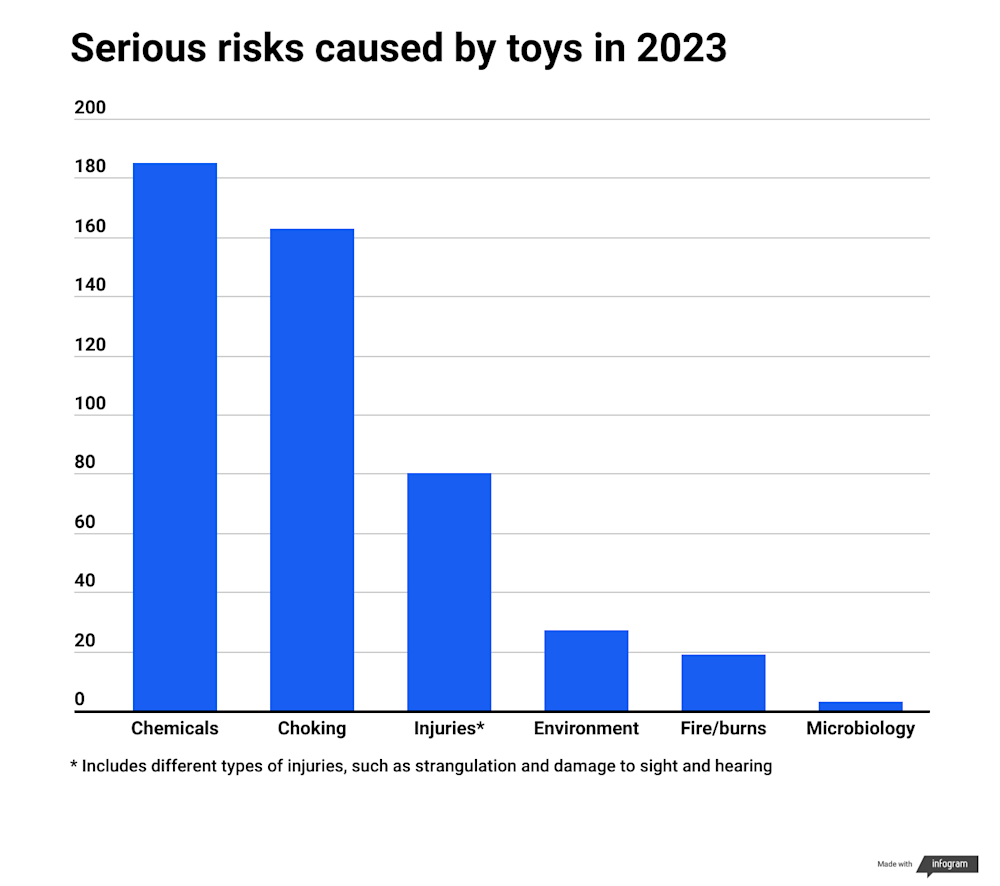
Some of the most common toxic chemicals discovered in toys in 2023 included the following:
More than 100 toys contained an excessive concentration of one or more phthalates, restricted plasticizers classified as toxic to reproduction. The phthalate concentrations in some toys were astoundingly high, often more than 30% by weight as compared to the legal limit of 0.1%.
Close to 30 toys released excessive amounts of boron, which may harm children’s reproductive systems.
More than 20 toys contained solders with excessive lead – and in some cases cadmium – concentrations, posing a risk to the environment.
Restricted preservatives, including isothiazolinones and formaldehyde, were found in several products. These may cause an allergic reaction to sensitized people.
Other restricted chemicals found in toys included endocrine-disrupting bisphenol A, carcinogenic nitrosamines, and short-chain chlorinated paraffins, which are classified as persistent organic pollutants.
Measurlabs’ testing expert Krista Alasalmi does not find it surprising that phthalates were the top finding in the toys category.
"Making toys out of cheap plastic, such as PVC, and using phthalates to process it can be very cost-effective for mass producers who mainly care about the margins and not the quality of their products," she says.
Dangerous toys were also found to pose various non-chemical and non-choking-related hazards:
Close to 20 toys were highly flammable, posing a risk of catching fire and causing burns.
A similar number contained small parts with high magnetic flux. If swallowed, such parts may attract one another and cause intestinal blockages.
More than ten toys contained projectiles with excessive kinetic energy, causing a risk of eye injuries.
More than 5 toys were found to cause damage to hearing through the production of loud sounds.
Numerous toys were found to violate multiple toy safety regulations and standards. One of the most striking examples was a multi-activity table from Hong Kong with excessive phthalate concentrations, detachable small parts, and high sound pressure that may cause hearing damage. Other examples included a toy gun set with detachable small parts and easily breakable protective glasses that may cause cuts and eye damage, as well as a plastic doll containing high lead-content solders, cadmium, several phthalates, and short-chain chlorinated paraffins.
An overwhelming majority of dangerous toys originated from China (83.2%). In 5% of the cases, the country of origin was unknown, and 2.6% of high-risk toys originated from Germany. At most three dangerous toys originated from any other single country.
Despite China’s prominence in the statistics, Alasalmi would not discourage buying Chinese toys from reputable retailers.
"Importers are responsible for their products’ safety, and legitimate companies generally make sure that the toys they import are tested appropriately. Customs also perform regular risk-based checks on Chinese toy imports," she notes and continues:
"On the other hand, I would definitely not order toys – or anything else for that matter – directly from Chinese online retailers, as there is no comparable quality control in such cases."
Motor vehicles: Mercedes-Benz was the most frequently reported brand
Over 400 serious risk alerts were filed in 2023 in the motor vehicle category. Injuries were the most common risk type, contributing to more than 300 cases. Over 90 vehicles caused a fire hazard, while around 30 posed a risk to the environment.
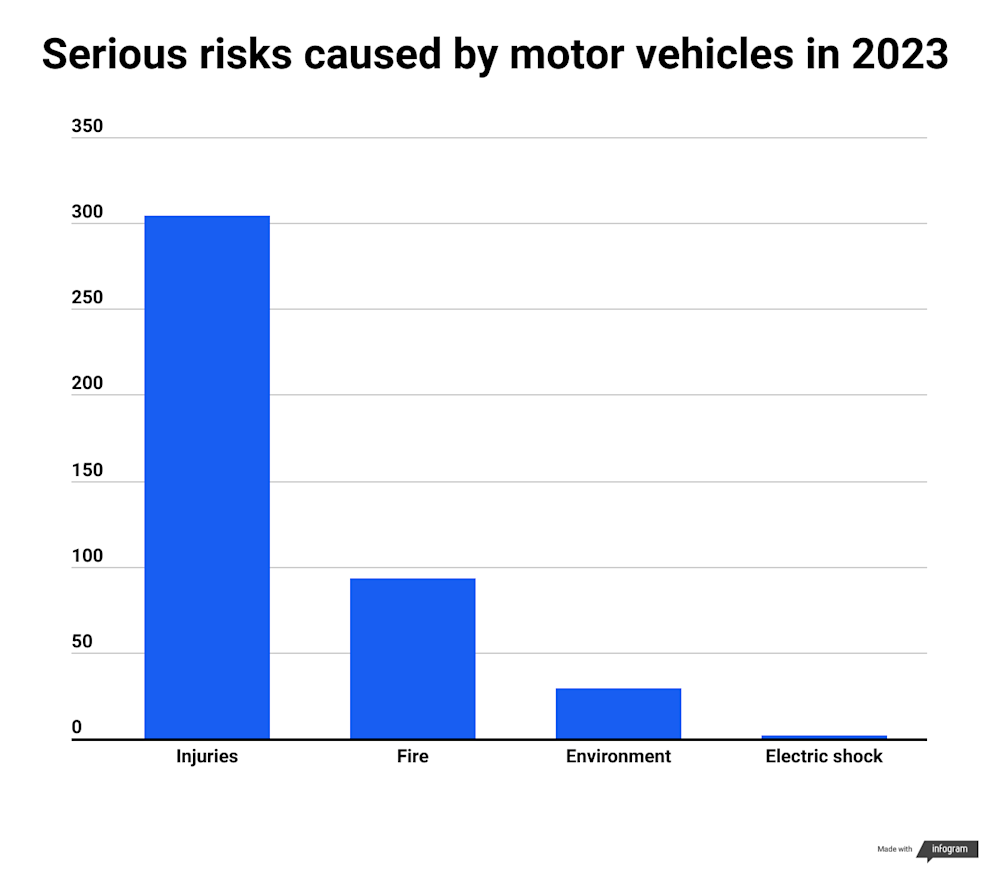
On a more concrete level, some of the most common reasons for motor vehicles being found dangerous in 2023 included:
Over 40 issues with braking systems, increasing the risk of traffic accidents.
More than 30 cases of faulty batteries, often leading to a fire risk.
Close to 30 fuel leakage risks, causing a fire hazard and endangering the environment and following traffic.
Over 15 short circuit risks, potentially causing a fire or increased risk of accidents.
Close to ten cases of faulty malfunction indicator lights (MIL) not activating as intended, resulting in higher emissions.
Dangerous vehicles originated most often from Germany (30.7%), France (17.7%), the US (8.7%), and the UK (6.7%). German and French authorities also performed most of the market surveillance, with around 60% of car-related Safety Gate alerts registered by German and around 26% by French authorities. Domestically produced vehicles were reported most often in both countries.
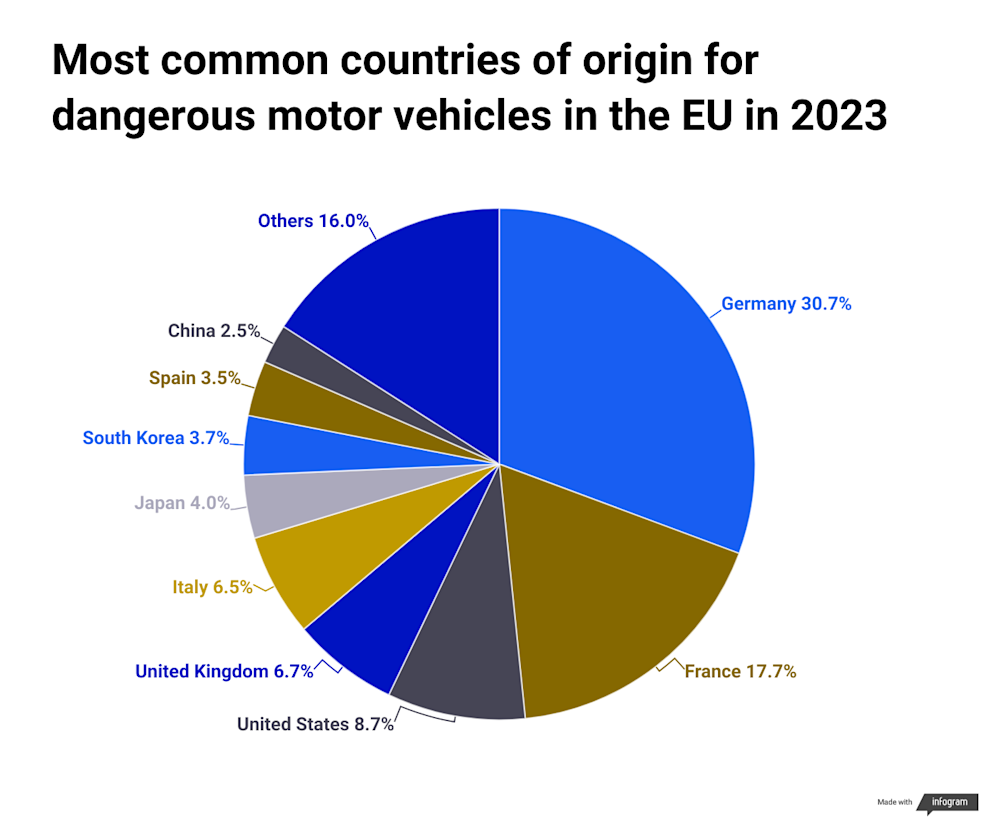
Mercedez-Benz was the car brand most often identified as dangerous in 2023. The brand’s cars were the subject of 47 serious risk alerts, clearly surpassing Peugeot at 28 alerts and BMW at 27 alerts. Opels, Citroëns, Toyotas, and Fords were also often found to cause serious safety hazards.
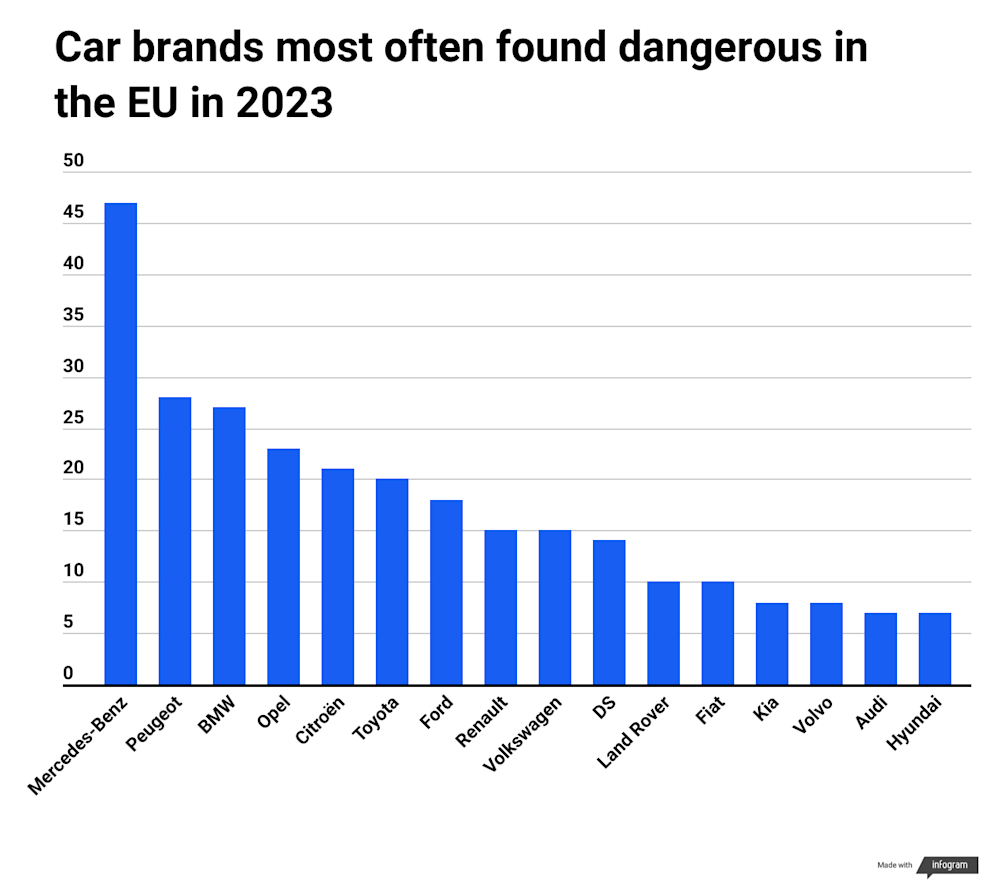
Dangerous electrical appliances were most often made in China
280 dangerous products were identified in the electronic equipment and appliances category in 2023. The hazards they caused were most often related to an increased risk of electric shock (124 cases) and chemicals harmful to the environment (120 cases). Many products posed two or more hazards, for example, containing harmful chemicals and increasing the risk of electric shock.
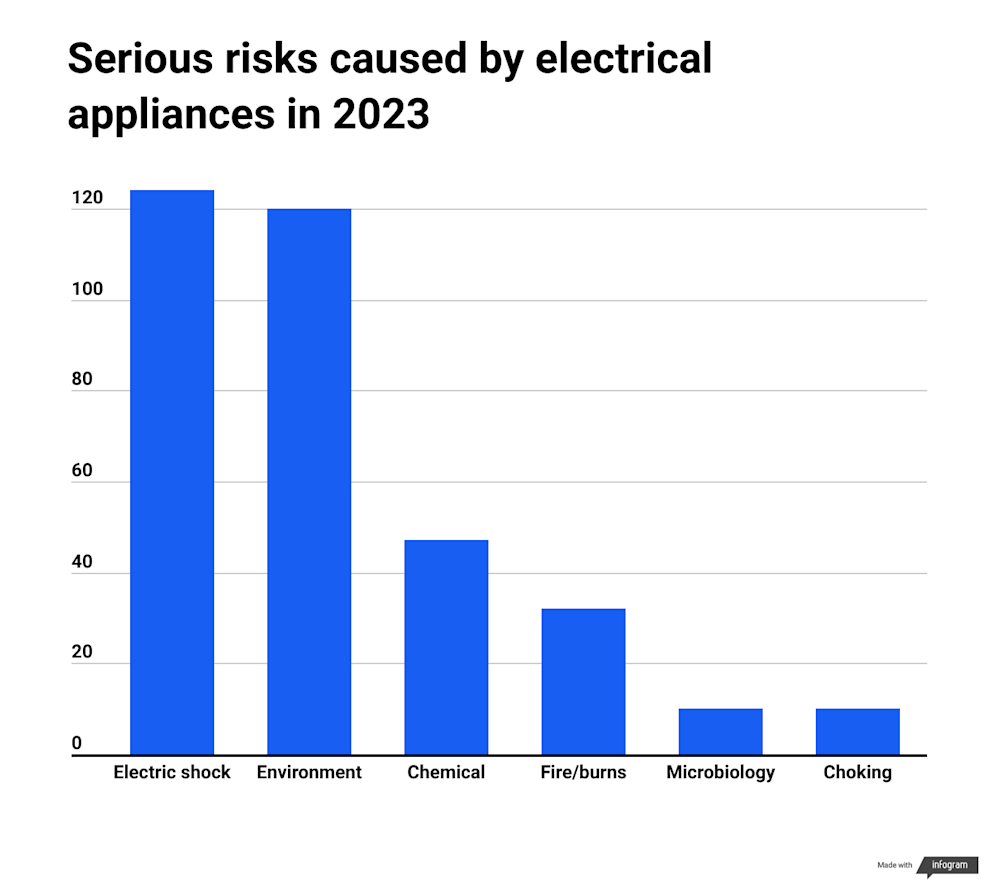
Some of the more specific reasons for electrical appliances being found dangerous in 2023 included:
Potential for overheating, resulting from reasons such as faulty or missing thermal cut-off switches, thin power cables, and faulty battery cells.
Insufficient electrical insulation, exposing live parts the user may touch, receiving an electric shock.
Microbiological hazards caused by uncleanable water tanks in air humidifiers, possibly leading to the development of mold.
Excessive concentrations of short-chain chlorinated paraffins, phthalates, lead, and cadmium, posing a risk to the environment and consumers.
Similarly to toys, China was the most common country of origin for dangerous electronic appliances by a significant margin, accounting for 77.5% of serious risk alerts. The country of origin was unknown for 15.4% of products, with a maximum of three dangerous appliances originating from any other single country.
Testing expert Krista Alasalmi points to the intense competition among mass producers as a likely explanation for the high number of dangerous appliances that originated from China.
"The need to keep prices very low doesn’t really leave room for quality control for these kinds of companies, whether they are producing electrical appliances or other consumer products," she remarks.
The fact that dangerous chemicals were frequently found in large quantities suggests that they are also used intentionally. According to Alasalmi, using phthalates to soften cheap plastics and lead to produce cheap solders is typical for some Chinese mass producers across several product categories.
“But there are, of course, also manufacturers in China who produce quality products, so not everything that originates from there is substandard,” she adds.
Clothes and fashion items caused strangulation risks and contained alarming heavy metal concentrations
A total of 275 textiles, clothes, and fashion items were identified as dangerous in the EU in 2023. The most typical hazards included injury and strangulation risks caused by long cords in children’s clothing, followed by harmful chemicals.
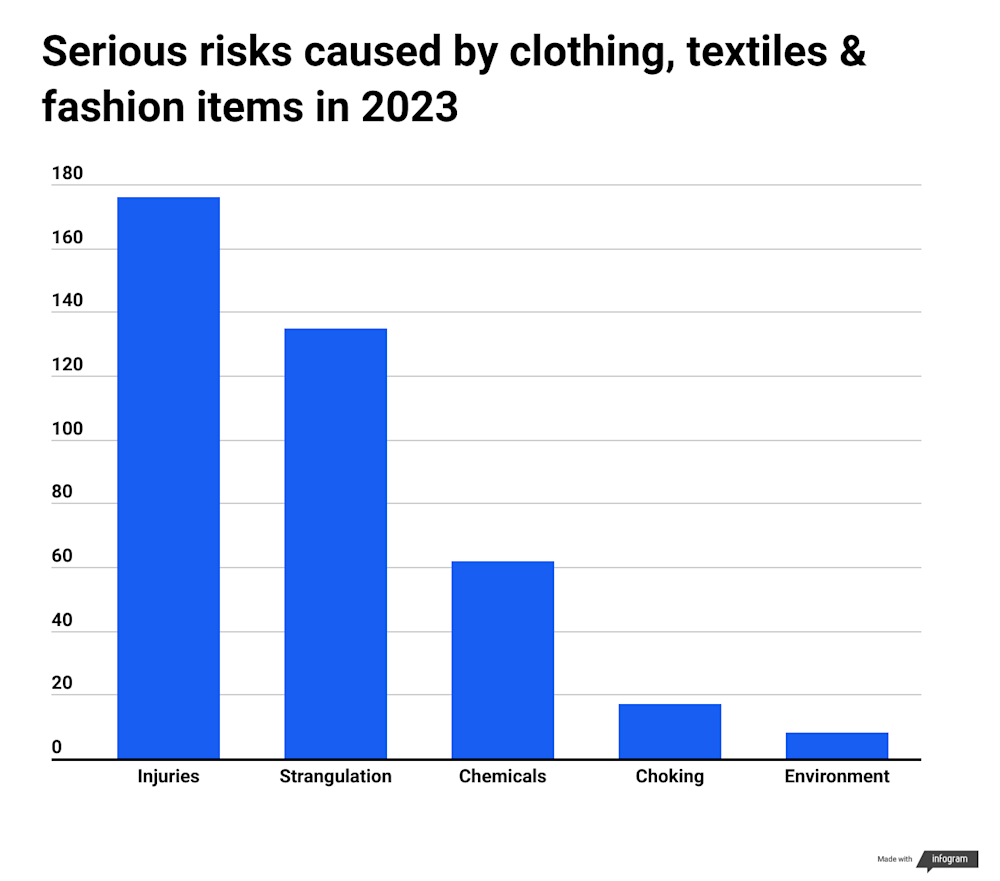
The most common toxic substances found in clothing and fashion items included phthalates, hexavalent chromium, cadmium, lead, and nickel. Phthalates were typically found in plastic-containing articles, such as flip flops, rubber boots, and cosmetics bags, while heavy metals were often discovered in metal jewelry and solders of fashion items that contained electrical parts. Several metal accessories were primarily composed of cadmium, with concentration levels of up to 92% by weight. This is in striking contrast with the legal limit of 0.01%.
Almost all clothing items and accessories that contained extremely high toxic metal or phthalate concentrations were sold online, and in many cases, the brand was not specified. In general, widely recognized fashion brands were mostly absent from the list.
"This is to be expected, as well-known brands have their own strict quality requirements and a strong incentive to ensure their products’ compliance to protect the brand," Krista Alasalmi says.
Brand protection is not a concern for mass producers who sell unbranded products through online marketplaces. The risk of getting caught is also significantly lower, as products are shipped directly to the customer from the non-EU source country and are therefore rarely subject to inspections by the authorities.
“This may encourage mass producers to use cheap and shiny toxic metals like cadmium,” Alasalmi speculates.
The number of serious risk alerts increased considerably in multiple categories
The number of products reported as highly dangerous on Safety Gate remained relatively similar from 2020 to 2022, fluctuating between slightly over 1,800 to slightly over 1,900. Compared to this, the more than 3,100 alerts from 2023 represent a massive increase.
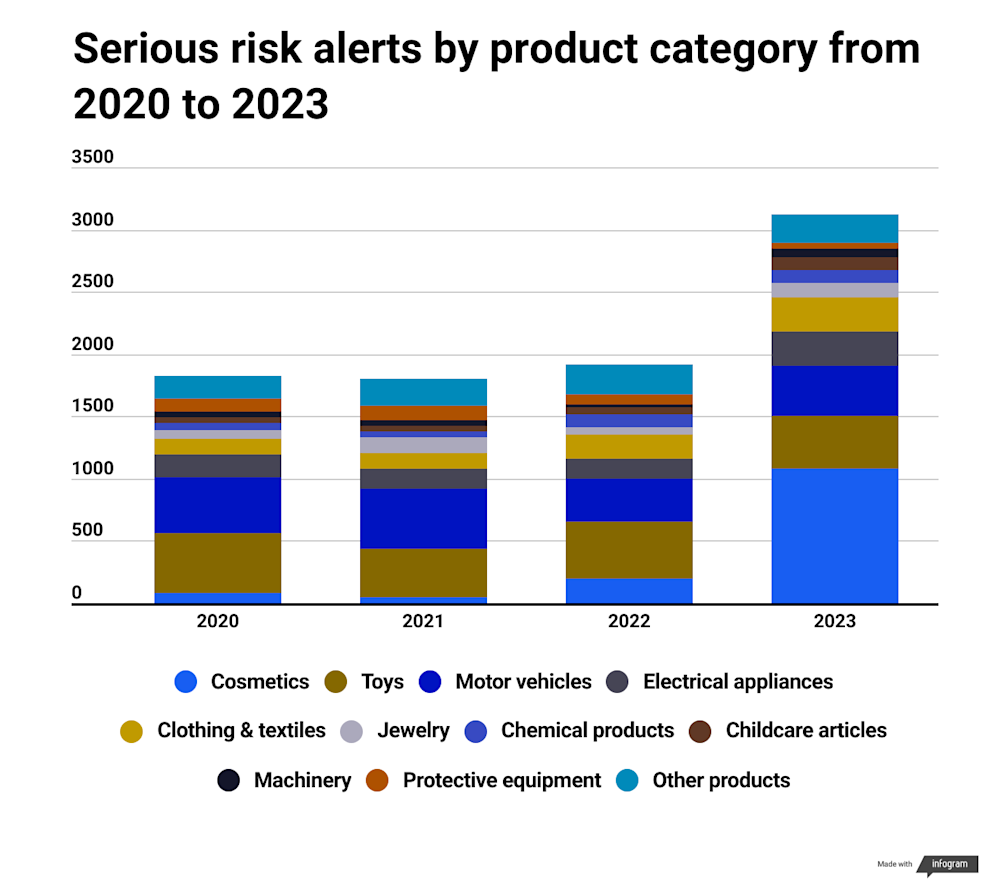
The increase in Safety Gate alerts does not necessarily reflect a similarly dramatic decrease in product safety. Most of the year-on-year growth is, after all, explained by a crackdown on Lilial-containing cosmetics that would not have been previously classified as dangerous.
A more representative comparison is achieved by removing alerts related to Lilial from the data for 2023 and 2022. With this change, there is still an increase in serious risk alerts, but it is less notable.
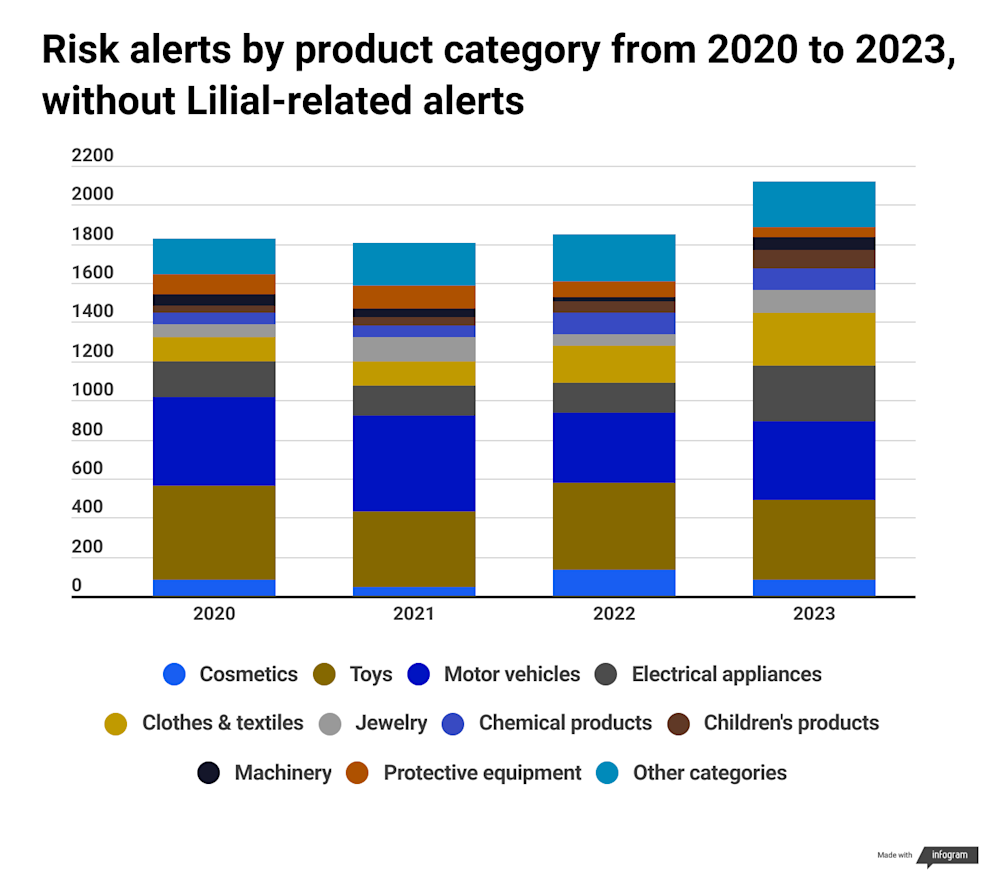
If the cosmetics regulation had not been updated to include Lilial, the largest number of dangerous products would have been identified in the toys category, similar to 2022. The removal of mostly Italian cosmetics from the data also underlines China’s role as the primary country of origin for dangerous products, as nearly 49% of the remaining products were Chinese. This is in line with previous years when Chinese products accounted for around half of all serious risk alerts reported on Safety Gate.
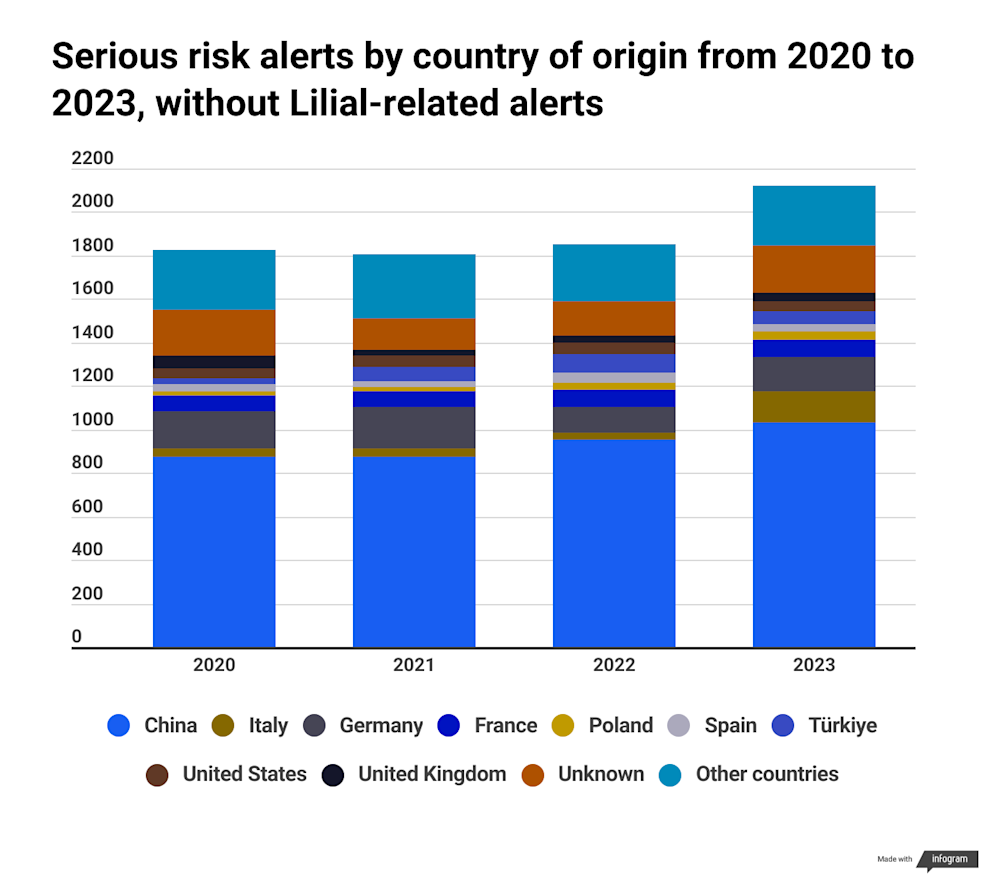
Krista Alasalmi suspects that the increased popularity of Chinese online marketplaces is one explanatory factor behind the growth in the number of dangerous products identified by authorities.
"I would strongly advise against ordering consumer products directly from online retailers based outside of the EU, as these kinds of small-scale imports often escape market surveillance efforts. And when checks are conducted, they frequently result in shocking findings, such as the cadmium jewelry and high-phthalate-content plastic we’ve discussed here," she concludes.
